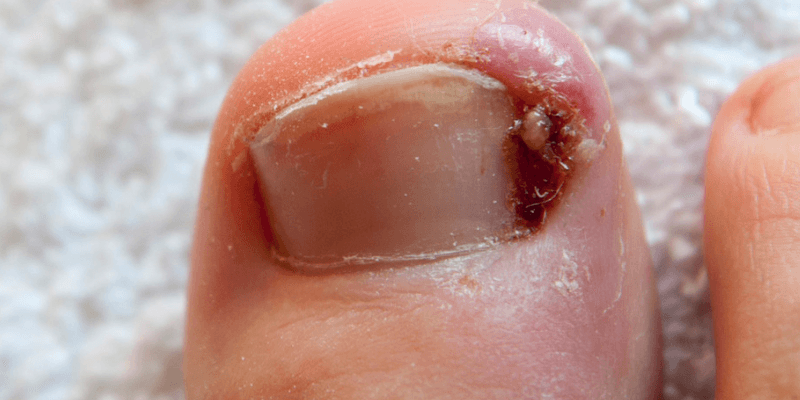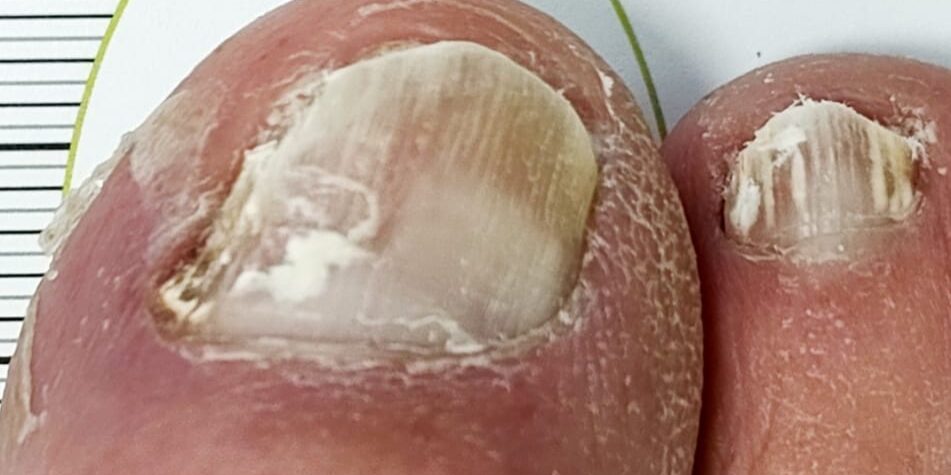How We Help

Ingrown Toenails
The pain
Ingrown toenails can cause significant pain and discomfort, affecting your daily activities and quality of life. This condition occurs when the edge of the toenail grows into the surrounding skin, leading to irritation, swelling, and tenderness.
The pain from an ingrown toenail is often sharp and persistent, intensifying with pressure from shoes or even light touch.
The impact
As the nail continues to dig into the skin, it can cause redness, warmth, and sometimes infection, characterised by pus or drainage.
This not only results in severe discomfort but can also hinder your ability to walk, exercise, or wear certain types of footwear comfortably.
If unresolved
If left untreated, ingrown toenails can lead to more serious complications, especially for individuals with diabetes or poor circulation.

The treatment
At Chapeltown Foot Clinic we can often manage the ingrown nail conservatively by cutting the ingrown spike out. If this doesn’t work or it isn’t possible, we can permanently remove the nail, or a section of the nail with nail surgery under local anaesthetic.
For more information see our blog post - How to treat ingrown toenails?
Corns & Callous
The pain
Callous and corns, hardened layers of skin that develop due to excessive pressure or friction, can cause significant pain and discomfort.
Corns are small, circular areas of thickened skin typically form on the tops or sides of toes or on the soles of the feet. The pain from foot corns can be sharp and persistent, especially when pressure is applied through walking or wearing tight-fitting footwear.
The impact
This discomfort can interfere with daily activities and work, making it difficult to walk or stand for extended periods. Additionally, the surrounding skin can become inflamed and tender, exacerbating the pain.
If unresolved
If left untreated, corns can worsen and potentially lead to infections, particularly in individuals with diabetes or compromised circulation.

The treatment
At Chapeltown Foot Clinic we can painlessly and quickly remove corns using a scalpel which will give relief for a period of time. Long term treatment may include regular removal, orthotics to off load pressure caused by walking, along with footwear advice.
We treat many patients who wear work boots and spend long periods on their feet. We’ve been able to comfortably remove their corns and callous creating instant relief. We also provide insoles to improve cushioning and foot function which has improved the discomfort whilst working, and extended the period of time between them needing to visit us.
For more information see our blog post - The best way to get rid of corns and callous
Heel Pain - Plantar Fasciitis
The pain
Plantar fasciitis, characterised by sharp heel pain, especially with the first steps in the morning, can significantly impact daily life. This condition arises from inflammation of the plantar fascia, a thick band of tissue that runs along the bottom of the foot, connecting the heel bone to the toes.
The impact
The pain can be debilitating, making it challenging to walk, stand, or engage in physical activities.
If unresolved
Without proper foot treatment, plantar fasciitis can worsen, leading to chronic heel pain and potentially causing compensatory issues in the knees, hips, or back as individuals alter their gait to avoid discomfort. Persistent, untreated plantar fasciitis can result in reduced mobility, weight gain due to decreased physical activity, and a diminished quality of life.

The treatment
Early intervention can provide relief through methods such as stretching exercises, orthotic support, and steroid injections, preventing long-term complications and restoring normal function and comfort.
Foot Pain - Morton's Neuroma
The pain
Morton's neuroma, a form of metatarsalgia, manifests as a painful condition affecting the ball of the foot, typically between the second, third and fourth toes. This ailment is caused by the thickening of tissue around one of the nerves leading to the toes, resulting in a lumpy sensation, burning pain, tingling, or numbness in the affected area.
The impact
The discomfort can make walking, standing, or wearing certain shoes unbearable, significantly impacting daily activities and overall quality of life.
If unresolved
If left untreated, Morton's neuroma can lead to chronic pain and permanent nerve damage, forcing individuals to alter their gait to avoid pain, which can subsequently cause issues in the knees, hips, and lower back. Additionally, the ongoing pain and discomfort can limit physical activity, potentially leading to weight gain and associated health problems.

The treatment
Seeking early treatment is crucial to alleviate symptoms, prevent further complications, and maintain an active, pain-free lifestyle. We can use steroid injections and orthotics to improve this condition.
A female patient at our foot clinic was struggling with this condition whilst at work. Her steel toe cap boots seemed to make the symptoms worse and she couldn’t wait for each break time when she could remove her boots and rub her foot. She came to see us and after a steroid injection and a pair of orthotics in her boots she no longer struggles through her shifts and can enjoy her break time with a coffee instead!
Fungal Nails
The pain
Fungal nails, characterized by discoloration, thickening, and brittleness, can cause significant psychological distress for patients.
The impact
The unsightly appearance of infected nails often leads to embarrassment, self-consciousness, and a reluctance to engage in activities that expose the feet, such as swimming or wearing open-toed shoes.
If unresolved
If left untreated, this can impact social interactions and overall self-esteem.

The treatment
At Chapeltown Foot Clinic we've been actively involved in a study exploring the effectiveness of a natural remedy called Funghiclear combined with thinning of the nails. Through this research, we've observed remarkable improvements in the appearance and health of fungal nails, offering patients a promising, non-invasive treatment option.
The positive results from Funghiclear not only enhance the physical condition of the nails but also significantly boost patients' confidence and psychological well-being, helping them regain comfort and pride in their appearance.
Other options for treatment at the clinic include nail surgery where the nail can be removed under local anaesthetic and fungal treatments applied directly to the nail bed as it heals.
For more information see our blog post - How to treat fungal nails?
Verrucae
The pain
Verrucae, also known as warts, can be both painful and unsightly, often causing discomfort when walking or standing.
The impact
These warts typically appear on the soles of the feet and can be particularly troublesome due to the pressure placed on them.
If unresolved
While most verrucae resolve spontaneously over time, some are stubborn and persist.

The treatment
For stubborn cases, dry needling is an effective foot treatment option, designed to provoke an immune response that targets and eliminates the wart. This method helps the body recognise and fight the verrucae, leading to their eventual resolution.
A nurse visited us after several months of treating a verruca on her heel with expensive and time consuming over the counter treatments. There had been no improvement and the verruca was affecting her shifts where she was on her feet for long periods. Six months after dry needling the verruca finally disappeared.
FAQs for Chapeltown Foot Clinic Podiatry & Chiropody Services
Yes, if you have a healthcare scheme, such as Westfield Health, you may be able to claim for your podiatry treatments. Because our podiatrists are HCPC-registered, treatments provided are eligible for reimbursement under many healthcare plans. We recommend checking with your specific provider to confirm your coverage and any claim requirements.
Podiatrists treat such a wide range of problems, all requiring their own specific treatment plan and techniques. So there isn’t one price we can quote, but as a guide our initial assessment appointment is £45.
The causes of heel pain are varied but include plantar fasciitis, Achilles tendinitis, heel spurs, and bursitis.
As a consequence the treatments need to be varied too, so we focus on creating a personalised treatment plan. These plans can include a range of treatment options including rest, ice therapy, specific stretching and strengthening exercises, physical therapy, corticosteroid injections for pain relief, and possibly orthotics to support proper foot mechanics.
To claim your podiatry treatment with Westfield Health, simply submit your receipt after your appointment. Westfield Health accepts claims from HCPC-registered podiatrists like ours, so you should be able to receive reimbursement for eligible treatments. If you have any questions or need assistance, feel free to ask our Chapeltown podiatry team for guidance.
The treatment of ingrown toenails depends on the presentation. We consider what has caused it, which nails are affected, and if there is severe infection present.
At Chapeltown Foot Clinic we provide a range of simple conservative options, as well as more advanced surgical treatments that include using local anaesthetic to treat the nail as painlessly as possible.
Podiatrists are specialists in diagnosing and treating fungal nails, and so we know that each case is unique. Every patient requires a diagnostic appointment and then a varying number of follow up appointments.
As an indicator our initial assessment appointment costs £45. Specialist tests and treatments are in addition to this.

12a Station Road
Chapeltown
Sheffield
S35 2XH


